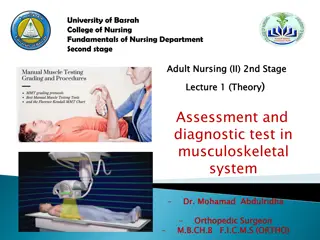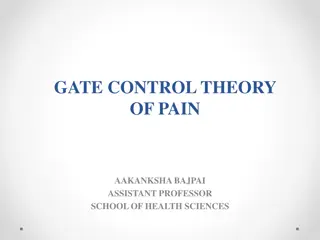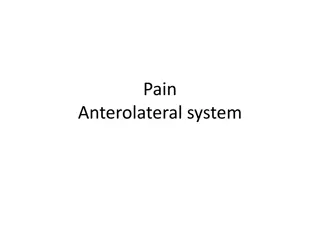Interferential Therapy for Pain Relief and Healing
Interferential therapy is a type of electrotherapy that uses electric currents to stimulate tissue for pain relief and other health benefits. This treatment method involves causing two medium-frequency currents to interfere with each other, promoting healing and reducing pain. Learn about the principles, parameters, and types of interferential therapy for effective treatment.
Download Presentation

Please find below an Image/Link to download the presentation.
The content on the website is provided AS IS for your information and personal use only. It may not be sold, licensed, or shared on other websites without obtaining consent from the author.If you encounter any issues during the download, it is possible that the publisher has removed the file from their server.
You are allowed to download the files provided on this website for personal or commercial use, subject to the condition that they are used lawfully. All files are the property of their respective owners.
The content on the website is provided AS IS for your information and personal use only. It may not be sold, licensed, or shared on other websites without obtaining consent from the author.
E N D
Presentation Transcript
StudyMafia.Org Interferential Therapy Submitted Studymafia.org Studymafia.org Submitted To: To: Submitted Submitted By: By: Studymafia.org Studymafia.org
Table Contents Definition Introduction Principle of Interferential Therapy Paramenter of Interferential Therapy How Interferential Therapy? Types of Interferential Therapy Treatment of Interferential Therapy Conclusion 2
Definition It is a type of electo therapy treatment that uses electric currents to stimulate tissue which provides pain relief, reduction of swelling and many other health benefits. 3
Introduction The principle of interferential therapy is to cause two medium frequency currents of slightly different frequencies to interfere with one another. It is basically used for the treatment of Chronic, Post Traumatic, and Post-surgical pains. IFT uses a range of frequencies that stimulate the body to get positive reactions such as increasing the blood supply in an area which in turn increases the healing speed. 4
Principle of Interferential Therapy It is to pass two medium frequency alternating currents which are the slightly out of phase , through the tissue., where the currents intersect to produce a low frequency effect . 6
Parameter of ContraceptivMethods Frequency : 100-150Hz constant or 90-100Hz rhythmic: These frequencies are useful for pain relief, IFT acts on large myelinated fibers in the dorsal horn, blocking off small pain fibers. The higher frequencies have a triggering effect on the endogenous opiates in the mid-brain which inhibit pain. 7
Parameter of ContraceptivMethods Frequency : 0-10Hz rhythmic or 10- 50Hz rhythmic: These frequencies are useful for muscle stimulation. They produce stimulation of deep, normally innervated muscle tissue with little sensory stimulation. As the frequency increases the contraction changes from a twitch to a titanic contraction. 8
Parameter of ContraceptivMethods Current : It is controlled by therapist . Equal to the sum of the two separate currents . The current is increased until the patient feels tingling. As accommodation occurs the intensity is increased to the point of muscle stimulation. 9
How Interferential Therapy Interferential current therapy works by sending small amounts of electrical stimulation to damaged tissues in the body. The therapy is meant to boost the body s natural process of responding to pain, by increasing circulation thus produces hormones that promote healing. 10
How Interferential Therapy IFT delivers intermittent pulses to stimulate surface nerves and block the pain signal, by delivering continuous deep stimulation into the affected tissue. Interferential current Increases the circulation of blood thus reduces swelling, by washing away the chemicals that stimulate the nociceptive nerve endings. 11
How Interferential Therapy A frequency of 100Hz may stimulate the large diameter A-beta fibers, which have an effect on the pain gate, and inhibit the transmission of small-diameter nociceptive traffic ( C and A-delta fiber), which effectively closes the gait to painful impulses. 12
Types of Interferential Therapy Plate electrodes : Made form conducting rubber Comfortable and long lasting Larger plates electrodes = deeper effect Smaller plates electrodes = superficial effect , localized effect Attached with strap for good contact 13
Types of Interferential Therapy Skin impedance Interferential therapy : Main problem of direct application of faradic or sinusoidal currents to patient is the very high skin impedance . Medium frequency current of around 4000Hz , while able to stimulate motor and sensory nerves, encounter a much Lower skin impedance . Impedance is inversely proportional to frequency. 14
Types of Interferential Therapy Formula of skin impedance : Z= 1/2 pfC where , Z = impedance in ohms f =frequency in hertz C= capacitance of skin in micro farads the resistance of the skin 50 Hz is in the region of 3200 O where as with the frequency of 4000 Hz skin re\ sistance is 40 O . 15
Types of Interferential Therapy Vacuum electrodes : Made forma vacuum unit plug into a rubber suction cup connected to a machine Suction should not be apply constant because it can be uncomfortable and causes burning For better adherence = placed wet spongers in the cup and moisten the edges For excellent treatment = flat smooth area [ back or plump knee ] 16
Treatment of Interferential Therapy Patient position = comfortable . Skin = washed and apply petroleum jelly on the lesions . After that place the electrode on the site of treatment . Instruct to patient if feel a tingling sensation please tell to therapist . On that time decrease the intensity . 17
Conclusion Nemec in the early 1950's. He wanted to overcome the problems of discomfort caused by low-frequency currents, while maintaining their claimed therapeutic effect. It remained disappear until 1970s, when work on pain mechanism by Melzack/Wall showed that pain could be reduced by stimulating primary afferent neurons. 18























